Fifty years ago
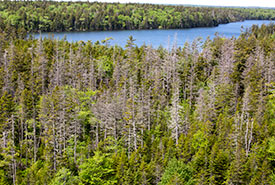
Abraham Lake Nature Reserve, NS (Photo by Len Wagg)
Fifty years ago, as a junior forester, I was introduced to “Big Red.” Towering above the other red spruce trees in a classic example of old-growth Wabanaki (Acadian) forest, Big Red was located near the trailhead of the Nature Conservancy of Canada’s (NCC's) Abraham Lake Nature Reserve and greeted all who ventured into this forest. Standing over 25 metres tall, with a diameter exceeding 70 centimetres, this majestic tree was over 300 years old. Unfortunately, Big Red was a bit of a loner. There were few, if any, siblings of similar size or age. It appeared that this large red spruce was a survivor of some long-ago disturbance.
This forest, near Abraham Lake, Halifax County, Nova Scotia, was recognized for its old-growth components by the International Biological Program in the 1970s. Big Red’s progeny at this time were already over 100 years old, and they created an impressive overstory of very tall and large red spruce trees. In the shaded understory of the forest were other layers of younger and shorter red spruce and balsam fir. The forest floor was covered thickly in a variety of woodland mosses and liverworts, typical flora and many, many smaller tree seedlings. And while this forest was a healthy ecosystem, many trees that had succumbed earlier to insect, disease or windthrow had fallen and were slowly rotting and melding into the forest floor.
This woodland was donated to NCC by Scott Worldwide Inc. in 1995, and in 2006 it was designated as the Abraham Lake Nature Reserve under the Nova Scotia’s Special Places Protection Act. The reserve, which totals 383 hectares, is now jointly managed by NCC and the province. With signage and trail enhancement, visitors and researchers to the Abraham Lake Nature Reserve have been treated to a memorable experience observing and studying the biodiversity and ecology of this old-growth forest.
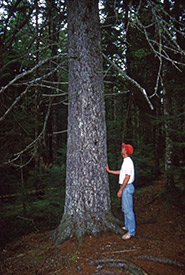
Peter Neily with Big Red in 1996 (Photo courtesy of Peter Neily)
Red spruce has longevity and shade tolerance, two attributes that factor heavily into the continuance of the red spruce ecosystem in the Wabanaki (Acadian) forest. Yet all trees must sooner or later experience mortality, and so it happened to Big Red near the turn of the century. Time and weather laid Big Red to rest on the forest floor, providing habitat for a variety of mammals, amphibians, invertebrates and fungi, and releasing nutrients into the soils. I remember travelling the trails after the tree had fallen and wondering which of the other trees would succeed Big Red. Never did I imagine what would follow.
In 2016, my job as a forester with the Nova Scotia government afforded me an opportunity to fly over the Abraham Lake Nature Reserve to observe the eastern spruce bark beetle attack that had been well underway for several years. Already, many of the oldest red spruce trees were greying and dying, and many had fallen to the forest floor. Others, though, would remain standing as snags, offering opportunities for birds to use them for nesting, perching, resting, feeding and mating.
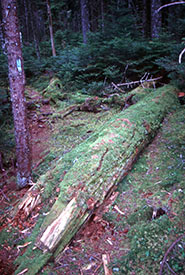
A tree that has fallen over continues to give life as it decays and returns nutrients to the forest floor (Photo by Peter Neily)
A 1999 old-growth study I had participated in revealed at least three age classes (165, 120 and 80) in the overstory of this forest. Big Red would have made four. It was difficult to discern these age classes from the ground, as the trees were all large and had similar height (20–25 metres) and diameter (30–45 centimetres). Red spruce trees have an uncanny ability to maintain themselves in a densely shaded understory. Often, trees only two to three meters tall can easily reach 30–50 years of age, but when given light from above they can grow rapidly into the upper canopy and achieve remarkable height and diameter growth. Because of this, only the bark gives a clue as to which trees might be older.
Forest ecosystems experience mortality somewhat differently to individual organisms. The agents of forest disturbance are many and can reach varying levels of severity. Typically, old-growth red spruce experiences the loss of a few individuals annually, and occasionally the creation of a small gap or patch. Hurricanes and fires are the typical agents of severe destruction and historically have been infrequent occurrences. Recent destructive hurricanes, including Carol (1953), Edna (1954), Hortense (1996), Juan (2003) and Dorion (2019), missed this part of Nova Scotia. However, it is possible that the great Saxby Gale of 1869 may have been a contributor to one of the storm cohorts. A nearby ecosystem archaeological study in 2016 revealed through carbon dating that two fires, 500 and 1,100 years ago, have also influenced the forest in this area.
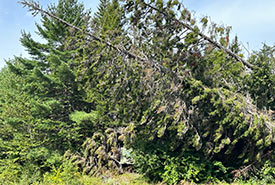
Some of the destruction that Hurricane Fiona left behind in 2022. (Photo by Peter Neily)
Sadly, the arrival of tropical storm Fiona in September 2022, packing winds of 120 kilometres per hour, toppled and broke trees to the extent that the overstory in many parts of the nature reserve was completed destroyed. This was especially true of the oldest portion to the south of Abraham Lake: Big Red’s neighbourhood.
I saw the nature reserve again this past summer and was dismayed by the destruction. Uprooted trees lay toppled on each other. Snags from the bark beetle epidemic still stood in some places as stark reminders of this earlier event. Remarkably, there were still many large red spruce trees left alive. Individuals and small patches can still be found throughout the site, although their future is in jeopardy as they are likely weakened and will be susceptible to winter storms over the next few years. There were also many young trees (two to four metres tall) that were relatively unscathed, and the much smaller advanced red spruce regeneration seemed anxious to start renewing this forest ecosystem.
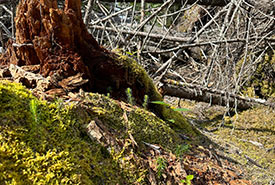
Post Hurricane Fiona. Photo shows very young red spruce, balsam fir and yellow birch seedlings which will be a significant component of the next forest (Photo by Peter Neily)
Many will despair the loss of this magnificent old-growth forest, but nature needs to provide for all biodiversity, and disturbances such as Fiona can offer opportunities for many species that would not normally find an old-growth forest suitable. Soon, a young vigorous forest will be recognized as the replacement of a once-outstanding example of the red spruce Wabanaki (Acadian) forest. And though it is extremely unlikely that many will be able to find, let alone follow, any of the old trails, new trails will be established. And perhaps a new and younger Big Red will be appointed by the forest to welcome another young forester, 150 years from now.


